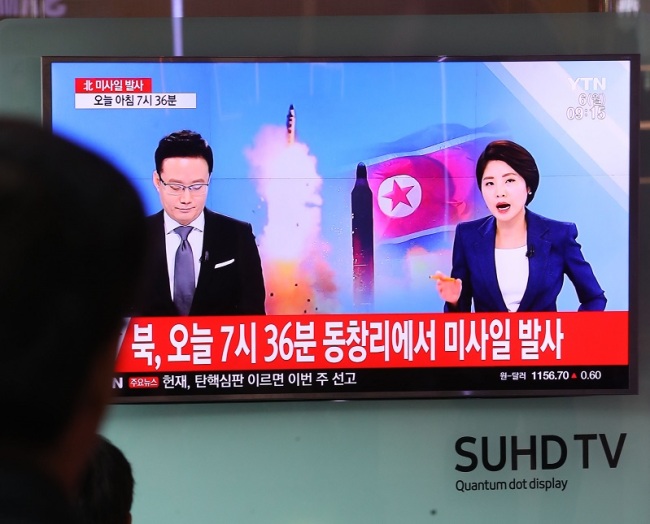North Korea launched four ballistic missiles into the Eastern Sea on Monday, Seoul’s military said, in an apparent show of force against ongoing annual South Korea-US military exercises.
The missiles lifted off at 7:34 a.m. from the North’s Dongchang-ri launch site and flew at least 1,000 kilometers, according to Seoul’s Joint Chiefs of Staff. The Japanese government said three of the projectiles fell in the country’s exclusive economic zone, as close as 300 kilometers to its northwestern shore.
 |
(Yonhap) |
Based on its initial assessment on the missiles’ trajectory and angle, the JCS said they are unlikely to be intercontinental ballistic missiles capable of reaching the US continent. The projectiles appear to have been fired sequentially at 75-93 degrees and reached a maximum altitude of 260 kilometers.
“I think it is quite unlikely (that the missiles are ICBMs), and we’re conducting more detailed analysis with the US (on missile classification),” JCS spokesman Col. Roh Jae-cheon said in a press briefing, leaving open the possibility for different types of projectiles and launchers being employed.
The latest provocation coincided with the Foal Eagle field training exercise, which began March 1 at its largest-ever scale with the participation of top US strategic assets including a nuclear-powered aircraft carrier, stealth fighters and a nuclear bomber.
Shortly after the JCS report, acting President Hwang Kyo-ahn convened a meeting of the National Security Council and condemned the launch as a “grave provocation.” He called for the deployment of THAAD, a US-led anti-missile system, in South Korea to be completed “as soon as possible.”
“North Korea’s nuclear and missile provocations pose existential and imminent threats to the lives and safety of our citizens,” Hwang said during the session. “While finishing the THAAD deployment to secure a defense system against the North’s nuclear and missile programs, we will actively take steps to enhance the US’ extended deterrence in a substantive manner.”
National Security Office chief Kim Kwan-jin and US National Security Adviser H.R. McMaster had a phone conversation, during which they pledged to strengthen their joint efforts to adopt “strong, effective” sanctions and pressure against Pyongyang, Cheong Wa Dae said in a statement.
Foreign Minister Yun Byung-se and his Japanese counterpart Fumio Kishida also held talks via phone to boost policy coordination, while Kim Hong-kyun, Seoul’s top envoy to the six-party nuclear talks, held back-to-back telephone talks with his Japanese and US counterparts, condemning the missile test and calling for a robust response, the Foreign Ministry here said.
The ministry issued a separate statement, saying the launch, coupled with the recent killing of Kim Jong-nam, the half brother of the North’s leader Kim Jong-un, laid bare the regime’s “recklessness” and warned of “unbearable consequences.”
“The North must realize that its fanatical obsession with the nuclear and ballistic missile development will only hasten isolation and self-destruction,” the statement reads.
The US State Department also condemned the event as a violation of UN Security Council resolutions explicitly prohibiting Pyongyang’s use of ballistic missile technology.
“We remain prepared -- and will continue to take steps to increase our readiness -- to defend ourselves and our allies from attack, and are prepared to use the full range of capabilities at our disposal against this growing threat,” acting spokesman Mark Toner said in a statement.
South Korean Defense Minister Han Min-koo reiterated confidence in Seoul’s defense capability, saying any North Korean missile targeting Seoul would be shot down using the country’s own missile defense systems possibly with the support of the THAAD system scheduled to be stationed here this summer.
The ministry said it had enhanced its air defense posture after Monday’s missile launch, instructing all Patriot batteries to heighten their combat readiness and extending the employment of intelligence, surveillance, and reconnaissance assets.
Last month, North Korea test-fired a new intermediate-range ballistic missile, the Pukguksong 2. That may have been included in the Monday’s test, along with the Scud-ER with a range of about 1,000 kilometers, or the Rodong, which can fly up to 1,300 kilometers, military experts said.
By Yeo Jun-suk (
jasonyeo@heraldcorp.com)








